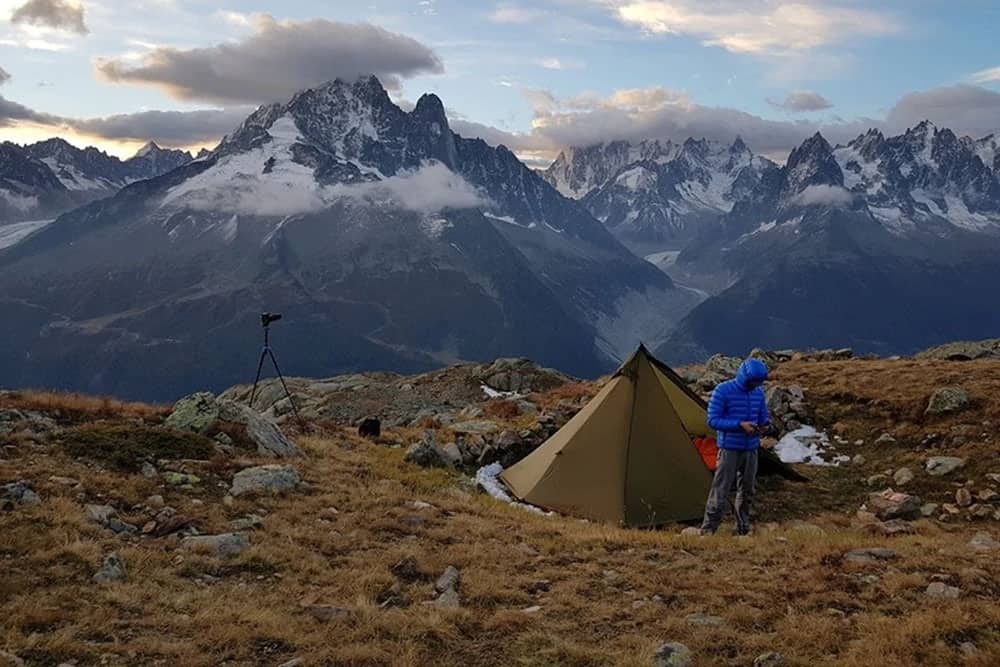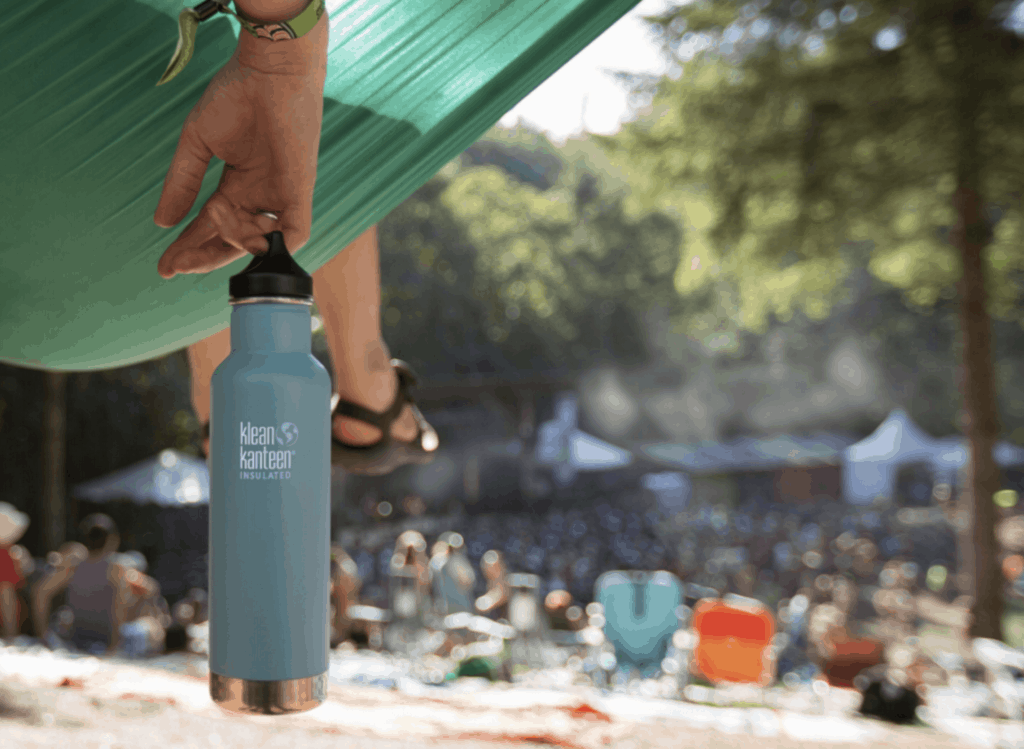If you’ve ever been at a shooting range or in the field duck or deer hunting you have some idea how loud guns actually are. And if you’ve been shooting or hunting without the aid of ear protection you’ve also arrived back home with your ears ringing, struggling to hear. While hearing usually returns to (what appears to be) normal after a day or two, the fact is some damage has been done. The more you fire your weapon without ear protection the worse that damage will be.
So while it may not look particularly cool to wear a pair of electronic ear muffs while brandishing your Glock 19, the person who does so won’t have to ask their grandkids to speak into their ‘good ear’ when they get older. We’ve taken a long look at dozens of different ear protection devices and distilled our list to the following 10. For the money they represent the best shooting ear protection on the market.
1. Walker’s Razor Slim Electronic Muff
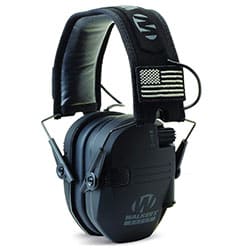
Walker’s Razor Slim Electronic Muffs sport a simple yet effective omnidirectional mic setup that eliminates high decibel noises while allowing you to retain situational awareness. Whether you wear them at the range or in the woods you won’t be shut out of your surroundings. But you will be protected from those 150+ decibel blasts that would wreak havoc with your inner ear.
They’re also comfortable, feature outstanding battery life, have a 3.5mm audio jack so you can listen to digital music and, maybe best of all, are right in everyone’s financial wheelhouse. Add to that the fact that they fold down nice and tight and have an NRR rating of 23 and you have one of the great values in ear protection.
2. Caldwell E-Max Hearing Protection

One of our goals with this list was to find effective electronic ear protectors that didn’t require spending the kids college fund to acquire. The Caldwell E-Max Hearing Protection ear muffs fit that description to a T. They’re comfortable, well-built with impact resistant shells, feature a 23db NRR rating and collapse down to nothing for packing.
They’re powered by 2 AAA batteries and have a standard audio input jack and adjustable volume control. So when you’re not hunting waterfowl you can hook up your smartphone and listen to your favorite tunes. Another thing we like about them is that they’re not as bulbous as some other ear muff ear protectors. They’re also available in 4 different color schemes including camo for you hunters.
3. Howard Leight Impact Pro High Noise Reduction

With the Howard Leight Impact Pro ear muffs we take a step up in quality, comfort and price. These Honeywell ear protectors feature an impressive NRR rating of 30. When sound levels reach 82 decibels the ear muffs automatically filter out anything exceeding that while enabling crystal clear sound on anything below that.
They’re powered by 2 AAA batteries and have an automatic cut-off feature that kicks in after 4 hours. Overall battery life is estimated at 350 hours. They’re very comfortable, build to last and, like most of their competitors, Honeywell tosses in a 3mm aux connector so you can hook up your smartphone and listen to music.
4. 3M Peltor Optime Ear Protectors

Like most non-electronic ear protectors these 3M Peltor ear muffs are fairly bulky. At the same time though they have an NRR rating of 30, are some of the most comfortable muffs we tested for long duration wear and they’re extremely affordable.
They feature the company’s ‘twin cup’ design. Which is basically just 3M’s version of a double shell. It’s this double wall cup that helps the Peltor achieve that 30 NRR rating. But it’s also what makes them so bulbous. Still, bulbous or not they get the job done effectively and reliably. They’re very well-made and won’t come apart on you after one trip into the field. And they cost about the same as a large pizza with everything.
5. MSA Sordin Supreme Pro X
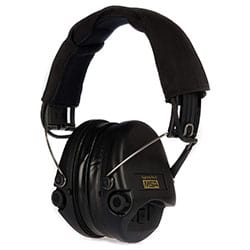
Earlier we alluded to the fact that some electronic ear muffs are pretty expensive. Well, the MSA Sordin Supreme Pro X ear muffs are an example of that. But they didn’t earn a spot on our list simply because they cost a lot. They earned a spot by being one of the best electronic ear protection systems on the market.
You can spend the whole morning bringing down waterfowl with your 12 gauge and break for lunch with nary a ring in your ear. There’s zero leakage around the edge of the muffs and the speakers produce high quality audio when you have your handset hooked up via the aux jack. The Supreme Pro X cans are built to last and the batteries should provide you with as much as 600 hours of operation.
6. Tradesmart Shooting Ear-Protection

This is a full service protective kit for the ladies featuring NRR rated 33 ear muffs, high quality BASF ear plugs straight from Germany and anti-fog, scratch-resistant goggles that offer UV 400 protection. The combination of earplugs and muffs provides robust protection against the loudest firearms.
Or they an be used separately if you so choose. Whether you’re a beginner or a pro you’ll appreciate the thoroughness of the protection this kit offers and also appreciate the handsome hardbody carrying case that comes with the kit.
7. Mpow 035 Noise Reduction Safety Ear Muffs
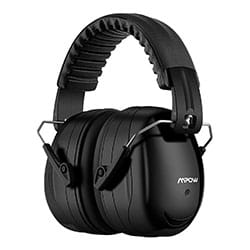
Mpow 035 Noise Reduction Safety Ear Muffs are another example of what’s good about standard (non-electronic) ear muff protection. They feature a very agreeable NRR rating of 28, are handsome and comfortable and they won’t break your bank. Much of their noise cancelling ability is derived from their double shell construction.
While the 360 degree rotatable cans and thick, pliable foam padding ensure you’ll achieve a nice snug fit every time. Whether in the wild or at the range you’ll walk away with your eardrums intact. If we had to nitpick we might mention that the ear openings could have been a bit larger since not everyone has average sized ears. Beyond that though they’re a great value for the budget conscious shooter.
8. Pro For Sho Maximum Hearing Protection

While it’s hard to look stylish while sporting ear muff style protectors Pro For Sho Maximum Hearing Protection muffs make a decent attempt to remedy that. Their ear muff protectors are svelte and sleek and available in 9 different colors. Whether that sort of thing is important to you only you can say. But if it is, these are the protective muffs for you.
They also happen to be very light, conform easily to your head and boast an NRR rating of 34. Pro For Sho makes their outstanding ear protectors available in adult, teen and child sizes as well. Which may go some ways in explaining what all the color choices are about. Still, that’s great. You can bring the kids along to the range and get them off on the right foot in their relationship with firearm safety.
9. Fnova Safety Ear Muffs

The final item on our list of best shooting ear protection is this pair of ear muffs from Fnova. These are simple yet very effective non-electronic ear muffs that conform nicely to your head and feature an NRR rating of 34. This latest iteration features upgraded foam material around the ears that improve overall comfort, especially over long durations.
They also seal up better than earlier versions. They adjust quickly and effectively, have a completely flexible headband and boast double shell construction that really blocks out the noise. With an attractive design, attractive price point and 60 day money back guarantee their a no-lose choice for the budget conscious.
10. Gloryfire Electronic Shooting Earmuff
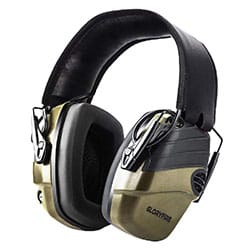
These Gloryfire Electronic Shooting Earmuffs are another example of outstanding quality and protection at an affordable price. Makes you kind of wonder why some electronic ear muffs cost as much as they do. Regardless, these Gloryfire muffs feature an NRR rating of 25 and will cancel out most noise over 82 decibels.
That means they filter out the damaging stuff while still allowing you to carry on normal conversations with your hunting partners or friends at the range. They also feature a 3mm aux input jack so you can listen to your favorite tunes and they fold down quickly and effectively to almost nothing for storage and transport. They’re not the most comfortable ear muff protectors we tested. But for the price they’re pretty hard to beat.
FAQs
How Important is Ear Protection When Shooting?
Very. Most people equate gun noise to what they hear in movies. But the gun noise you hear in movies is usually added after the fact and finessed in a way to make it sound more appealing. It’s part of the art of sound editing. If they used real gun sounds in movies half the audience would run from the theaters and the other half would sit there covering their ears.
Two movies that got gun noise and its ramifications more or less right were “Heat” from 1995 and “Black Hawk Down” from 2001. For the big bank heist shootout in Heat they decided to use the actual sound from the guns rather than dubbing in more agreeable sounds after the fact. The result is pretty astonishing (1). And in Black Hawk Down one of the Marines loses his hearing during a firefight. Which is an ever present danger for soldiers (2).
To drive the point home, consider this: a typical conversation between two people generates about 60 decibels of sound. Your neighbor’s gas powered lawn mower that drives you crazy on Saturday afternoons in the summer generates about 90 decibels. A jet airliner taking off generates about 140 decibels. And a 9mm pistol about 160 decibels. So guns aren’t just loud, they’re really, really loud.
Exposure to more than 85 decibels for an extended period of time can slowly eat away at your hearing in a process known as noise induced hearing loss or NIHL (3). While 140 decibels or more can cause immediate damage to the nerves of the inner ear. While the ringing in your ears may stop after a day or two the damage has been done and will manifest itself in time. The more you expose yourself to raw gun noise the greater will be the cumulative damage. So, you might think everything is A-okay a couple of days after the ringing stops. But 10 years down the line you’ll be saying “What? Can you speak up?” during a normal conversation.
Common Symptoms of Hearing Loss
People who live in the city their whole lives, ambulance drivers constantly exposed to sirens, soldiers (4) and gun enthusiasts who refuse to wear hearing protection are just some of the people who commonly suffer from hearing loss. Symptoms to be aware of include:
- Muffled sound instead of nice clear sound
- Persistent ringing in the ear (tinnitus)
- Difficulty distinguishing one sound from another
- Difficulty distinguishing where a sound is coming from
Are Guns Really That Loud?
Yes, guns really are that loud. And since any noise above 85 decibels can be harmful to your hearing it’s essential to wear ear protection whenever possible while firing a gun. The system used to measure gun noise is a logarithmic scale (5) wherein a 3 decibel increase indicates twice the sound energy. That means a gun that generates 160 decibels produces twice the sound energy of a gun that produces 157 decibels. Here is a more comprehensive list of the decibel levels of different firearms.
- 134 db – .22 LR rifle
- 150 db – .410 shotgun
- 152 db – .22 LR pistol
- 153 db – 20 gauge shotgun
- 155 db – .25 pistol
- 156 db – 12 gauge shotgun
- 157 db – .22 magnum pistol
- 158 db – .38 special revolver
- 159 db – .30-06
- 160 db – 9mm para pistol
- 164 db – .357 magnum revolver
- 164 db – .44 magnum revolver
If the sound energy doubles with every 3 decibel increase, and a jet airliner taking off produces 140 decibels it becomes apparent just how loud something like a .30-06 or a .44 magnum really is. Hopefully this will stoke your resolve to wear proper ear protection whenever possible.
What are the Different Types of Ear Protection?
There are several different types of ear protection you can use to mitigate gun noise, including:
Earplugs
Earplugs have been around seemingly forever and there are a number of good reasons why they endure. They’re cheap, small, easy to carry anywhere, easy to insert and remove and most of today’s best earplugs are very comfortable. They also don’t get in the way of your hat when it’s cold out or your glasses.
They’re not without their downside though. To begin with they don’t typically block as much noise as ear muff style protection does. On top of that they don’t always fit perfectly and they’re susceptible to falling out for that reason.
That said they are a big favorite of hunters who simply can’t be lugging around a pair of ear muff style ear protectors everywhere they go. Ear plugs also tend to be a favorite of construction workers, whose work environment is often loud but not extremely so. The exception being those who operate jackhammers or pile drivers. Earplugs just won’t do for them.
Standard Ear Muffs
This type of ear protection is very comfortable, doesn’t require sticking anything into your ear, won’t fall out and is generally better at providing protection against extreme noise levels than earplugs are. They’re also cheaper than electronic ear muffs.
Like everything else however, they also have a downside. That is, they’re larger and more cumbersome, it’s not easy to lug them around everywhere you go and they’re more expensive than simple earplugs. You’ll often see this type of ear protection being worn by people at the shooting range.
Electronic Ear Muffs
These are far more sophisticated items than standard ear muff protectors. Whereas earplugs and standard ear muffs simply put a wall between your ear and all sound, electronic ear muffs are more selective. They only block out noise that is above a certain decibel level.
There are a lot of advantages to this type of protection. If you are on a construction site you can hear what’s going on around you and better avoid accidents. If you’re in a factory you can carry on conversations without having to take off your ear protection. And if you’re hunting you can maintain contact with others in your party and hear what is going on in the woods.
The main drawback to this type of electronic ear muff is the price. While there are plenty that can be had for around $40 or even a bit less, some will cost as much as several hundred dollars. That’s a lot. But at the same time can you really put a price on your hearing?
Suppressors
Commonly known as ‘silencers’ suppressors (6) can reduce the amount of noise from a given firearm by up to 35 decibels. Suppressors are available today for every imaginable type of firearm, including shotguns. Besides the obvious benefit they provide the shooter they also provide a benefit to those around the shooter, as they lower the noise factor of the whole environment.
So what’s the downside? Well, they obviously make the gun heavier and more unwieldy. There are also many who believe they have a negative effect on accuracy. Although, if you really want to get an argument going just state this out loud at the firing range. Because there are just as many people who will swear they increase accuracy (7). But no one will argue with the fact that they cost an arm and a leg. And sometimes the lower portion of the remaining arm as well.
Using Both
If you are not in a position to afford electronic ear muffs or a suppressor (suppressors as we suggested can be prohibitively expensive) you might want to double down on the low tech ear protection. Earplugs coupled with standard ear muff-style protectors will certainly go a long way toward preventing hearing loss and are often recommended for situations where sound levels exceed 100 db (8).
What Is the NRR?
Whenever the discussion turns to ear protection you will hear the acronym NRR bandied about. NRR stands for Noise Reduction Rating (9). Simply put the NRR is a standard used to measure the effectiveness of a given set of earplugs or other ear protection device at reducing the amount of noise that reaches the ear. The calculus used to arrive at the various NRR ratings is enough to make your head spin (10). However, it essentially boils down to this; the higher the NRR rating the more noise it will block.
The Bottom Line
Going to the practice range can be both fun and rewarding. But if you’re not wearing adequate
protection when you shoot it can also be detrimental to the health of your ears. Same thing with hunting. Having that 12 gauge thundering away just inches from your ear all day while hunting waterfowl is not going to lead anywhere good if you don’t wear some type of ear protection. It also may be a good idea to invest in shooting gloves to protect your hands as well.
It’s as simple as that. Some hunters will opt for ear muffs. Others don’t want to be bothered lugging them around and prefer earplugs. But regardless your preference you need to use something. Hearing loss from gun use is an all too common tragedy that is completely preventable if you get into the habit of wearing adequate ear protection right from the start. Don’t sacrifice your hearing at the altar of machismo. Get yourself some quality ear protection and use it.
